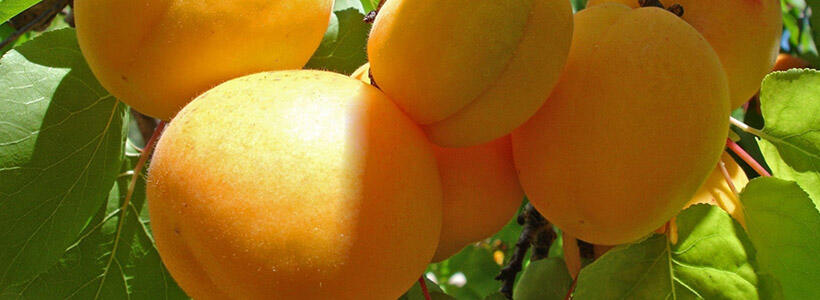
| Tarım Alanı | 425 045 Ha. |
| Ormanlık Fundalık | 112 705 Ha. |
| Çayır ve Mera | 572 729 Ha. |
| Tarım Dışı Arazi | 120 827 Ha. |
| Toplam Yüzölçümü | 1 231 306 Ha |
| Tarım Alanlarının Dağılımı | |
| Toplam Tarım Arazisi | 425 048 Ha. |
| Tarla Alanı | 334 745 Ha. |
| Tarla Alanı | |
| - Ekilen Alan | (178 551) |
| - Nadas | (156 194) |
| Sebzelikler | 3 404 Ha. |
| Meyvelikler | 78 932 Ha. |
| - Kayısı | (61 903) |
| - Diğer | (17 029) |
| Bağlar | 7 964 Ha. |
Malatya’da 425.045 hektar tarım arazisinin, 391 541 hektarı sulamaya elverişlidir. Bunun 198 715 hektarı (%50.75) sulamaktadır.
Sulanan arazinin; 59 004 hektarı halk sulamaları ile gerçekleştirilmektedir.
Devlet Su işleri’nin ve Köy Hizmetleri’nin inşaatları devam eden sulama projelerinin de tamamlanması halinde 63 1 94 hektar arazi daha sulamaya açılacaktır. Böylece sulanan arazi miktarı 261 909 hektara yükselerek, sulamaya elverişli arazinin %67’si sulanmış olacaktır.
Malatya’da bitkisel üretim ağırlıklı olarak kayısıya dayalıdır. Yıllık ortalama kuru kayısı üretimi 80 ile 100 bin t on civarındadır. İnşaatları devam eden büyük sulama projelerinin de tamamlanmasıyla birlikte kuru kayısı üretiminin %50 civarında artması beklenmektedir.
Dünya kuru kayısı piyasasının %90'ı Türkiye’ye aittir. Bunun da %70'i Malatya’dan karşılanmaktadır. Kayısıdan her yıl Ülke ekonomisine 1 30 ile 150 milyon ABD doları civarında döviz girdisi sağlanmaktadır.
Ancak pazar olanaklarının genişletilmesi amacıyla, Tarım II Müdürlüğü tarafından ilkin ve toprak koşulları bakımından yetiştirilmeleri mümkün olan tarım ürünlerine ilişkin çeşitlendirme projeleri hazırlanarak bu konuda gerekli çalışmalar başlatılmıştır. Bu proje kapsamında; Yeşilyurt ilçesinde kiraz ve Starking elma, Hekimhan, Pütürge, Doğanyol, Kuluncak ve Darende ilçelerinde ceviz yetiştiriciliği, Arapgir, Yeşilyurt, Pütürge ilçeleri ile Merkez ilçeye bağlı Konak Kasabası ve Beydağı civarında üzüm, Kale ilçesinde çilek ve il genelinde yem bitkisi üretimi geliştirilecektir.
Malatya’da hayvancılık, daha çok bitkisel üretimin destekçisi olarak algılanmakta ve sadece hayvancılık yapan çiftçi sayısı sınırlı kalmaktadır. Malatya’da coğrafi yapı nedeniyle yapılan çalışmalarda dağlık olanlarda koyun besiciliğinin yaygınlaşmasına, ovalık alanda ise süt sığırcılığının daha fazla geliştirilmesine önem verilmektedir. Zira mevcut durumda dağlık alanda yapılan küçükbaş hayvancılık yeterince verimli olmamakta, ovada yapılan büyükbaş hayvancılıkta ise istenilen ve beklenen üretimi sağlanamamaktadır.
Malatya’da arıcılık faaliyeti özellikle dağlık ve ormanlık alanlarda yaygınlaştırılmaktadır.
I - Malatya’yı GAP Bölgesine bağlayacak olan Malatya-Adıyaman-Yeşilyurt Karayolu Projesi tamamlandığında 70 km.lik bir kısalma olacaktır. Proje tamamlandığında Malatya’nın hammadde temini ve pazara erişim açısından GAP’ın merkezindeki Şanlıurfa’yla, Adıyaman üzerinden daha hızlı bağlantı kurulabilecektir.
II - 1 Km’lik projenin Adıyaman tarafındaki 55 Km’lik kısmı tamamlanmıştır. Malatya tarafından ise 22 km’lik bölümü 1991 yılında ihale edilmiş, 1999 sonu itibariyle 2.5 km’lik heyelanlı kısmı hariç 19.5 km. asfalt seviyesinde bitirilmiştir.
Adıyaman-Malatya bağlantısının sağlanabilmesi için arada kalan 34 km. yolunda projesi hazır olup, maliyeti 10 trilyon TL’dir.
Her gelen yıl yerli ve yabancı turistlerin daha çok ilgisini çeken Nemrut Ören yerine en kısa ve en kolay yoldan Malatya üzerinden ulaşılmaktadır. Ancak özellikle Tepehan-Nemrut arasındaki yol çok yetersizdir. Bu amaçla 94 Km’lik (Elazığ-Malatya) Ayr.-Tepehan-Ayr.-Nemrut Dağı-(Narince-Gerger) yolunun projesi hazırlanmıştır. Proje tamamlandığında Malatya’nın Pütürge ilçesi ile Adıyaman’ın Kahta ilçesi, Nemrut Dağı üzerinden karayolu ile birbirlerine bağlanarak, böylece Malatya’ya gelen turistlerin GAP bölgesine, Adıyaman’dan gelen turistlerin de Malatya, Elazığ ve diğer Doğu illerine kısa yoldan gitmeleri sağlanmış olacaktır.
Malatya’da il merkezinde yoğunlaşan sanayinin belli bir ivme kazandığı, göreli bir üstünlük yakaladığı ve kentte sanayi oluşumunu birikimli bir döngüsel sürece sokan dışsal ekonomilerin ve üretici hizmetlerin oluştuğu bellidir. Örneğin, üretici hizmetlerinin bir kesiminin bir göstergesi olarak alınabilecek serbest meslek ve hizmetlerde oluşan gayri safi katma değer 1987-1997 arası %53 artmıştır. Malatya ili bu faaliyetlerde 1997'de tüm Bölgede yaratılan katma değerin %30'una yakınını yaratır hale gelmiştir.
Malatya ili sanayide belli bir ivmeyi yakaladığı için tüm Bölge’de en hızlı gelişen ildir. İlin toplam gayri safi katma değeri 1987-1997 arasında üçte bir (%33,82) artmıştır.
Bu ilerlemeden şu sonuç çıkmaktadır. Malatya sanayileşmede son zamanlarda bir atılım yapmış ve diğer sektörleri, özellikle geri bağlantılı olduğu sektörleri birlikte sürüklemeye başlamıştır. Malatya’nın sanayideki bu ivmesi konusundan çeşitken bir tarımın hakim olduğu bir ovada bulunmasından ve eğitim düzeyi ile ölçülebildiği kadarıyla daha becerikli insan kaynaklarına sahip olmasından kaynaklanmaktadır. Bunda kuşkusuz girişimciliğin rolü vardır. Malatya son on-beş yıldır gösterdiği sanayi performansıyla, sanayinin belli alt sektörlerinde göreli üstünlüğe sahip olduğunu göstermiştir. Sanayinin çeşitlenmesi ve üretici hizmetlerin gelişiyor olması Malatya’da yığılma ekonomilerinin geliştiğine de işaret etmektedir.
İmalat Sanayinin Sektörel Dağılımı
Malatya’da 3'ü kamuya, 131'i özel sektöre ait olmak üzere toplam 134 adet orta ve büyük ölçekli sanayi tesisi mevcuttur. Bu tesislerin 86’sı Organize Sanayi bölgesinde faaliyet göstermektedir. Ayrıca 42 adet orta ve büyük ölçekli sanayi tesisi de inşaat halinde olup, bunlardan 31'i 1. Organize Sanayi Bölgesinde bulunmaktadır. Organize Sanayi Bölgesinde yapımına başlanmamış olan 4 Sanayi Tesisi ise henüz proje aşamasındadır.
Seçilmiş Sanayi Ürünleri Üretimi
| Sektörler | 1987 | 2000 | ||||
| Kamu | Özel | Toplam | Kamu | Özel | Toplam | |
| Gıda | 2 | 4 | 6 | 1 | 57 | 58 |
| Tütün | 1 | 1 | 1 | - | 1 | |
| Tekstil | 1 | 3 | 4 | 1 | 38 | 39 |
| Makine | - | 1 | 1 | - | 15 | 15 |
| Orman Ur. | - | 2 | 2 | - | 4 | 4 |
| Taş. Toprak | - | 3 | 3 | 12 | 12 | |
| Plastik | - | 1 | 1 | 5 | 5 | |
| Toplam | 4 | 14 | 18 | 3 | 131 | 134 |
| Ürün | Üretim | Miktar |
| Şeker | 47 000 | Ton/Yıl |
| Sigara | 17 000 | Ton/Yıl |
| Pamuk iplik | 50 489 | Ton/Yıl |
| Dokuma | 59 744 000 | M/Yıl |
| Un | 176 000 | Ton/Yıl |
| Kuru Kayısı | 53 000 | Ton/Yıl |
| Kireç | 47 000 | Ton/Yıl |